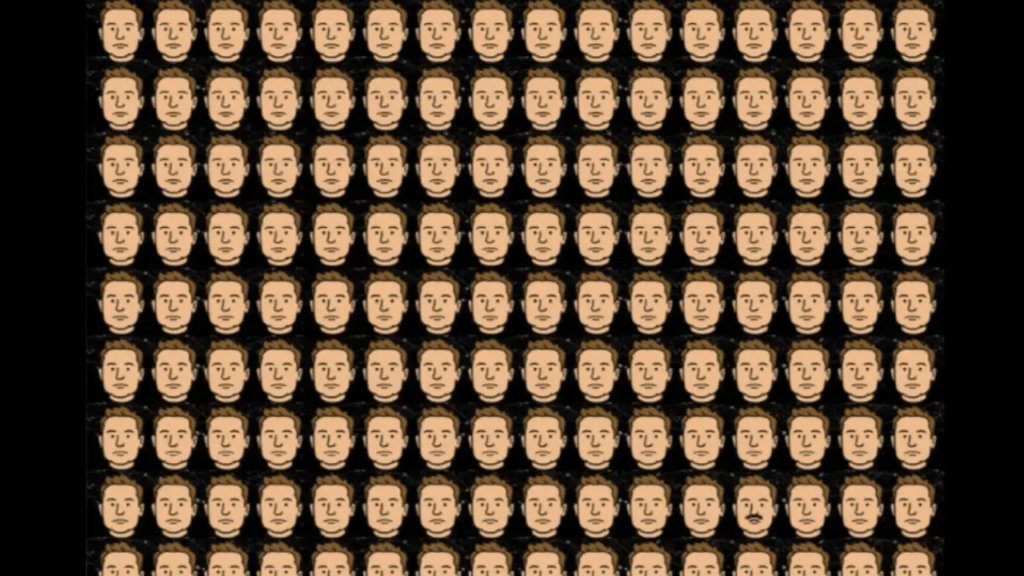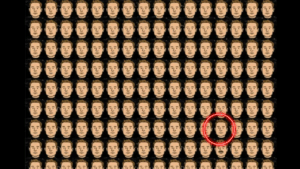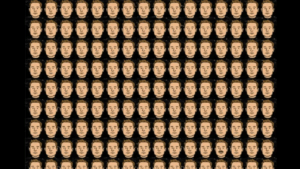
Optical illusions have fascinated humans for centuries, blending art, psychology, and neuroscience into captivating visual puzzles. These mind-bending images challenge our perception, making us question what we see and how our brains process visual information. One popular type of optical illusion involves spotting the “odd one out” in a seemingly uniform pattern. In this article, we explore a specific challenge: an optical illusion featuring a grid of faces where one face differs from the rest. Can you spot the odd face? We’ll delve into the science behind optical illusions, why they trick our brains, how to solve this particular puzzle, and tips to sharpen your perception skills. Let’s embark on this visual adventure!
What Are Optical Illusions?
Optical illusions are images or patterns that deceive the eye, causing us to perceive something that doesn’t align with reality. They exploit the quirks of our visual system, revealing how our brains interpret shapes, colors, and patterns. Illusions can make stationary objects appear to move, distort sizes, or hide objects in plain sight. The “odd face” illusion, where one face in a grid stands out due to subtle differences, is a classic example of a “search” illusion, testing our attention to detail.
Types of Optical Illusions
-
Literal Illusions: Create images different from the objects that make them (e.g., a face formed by clouds).
-
Physiological Illusions: Result from overstimulation of the eyes or brain (e.g., afterimages from bright lights).
-
Cognitive Illusions: Exploit assumptions our brains make about the world (e.g., the odd face puzzle, where we assume uniformity).
The odd face illusion falls under cognitive illusions, as it relies on our brain’s tendency to group similar objects, making the outlier harder to spot.
The Odd Face Illusion: What to Look For
Imagine a grid of 5×5 faces, each depicting a similar expression, color scheme, or design. Among these 25 faces, one is slightly different—perhaps in the shape of the eyes, the tilt of the mouth, or a subtle color variation. The challenge is to identify the odd face within a limited time, often under 30 seconds, to test both speed and accuracy.
Why It’s Tricky
Our brains are wired to recognize patterns and group similar objects, a process called “gestalt grouping.” In a grid of nearly identical faces, we initially perceive uniformity, which masks the oddity. The subtle difference in the odd face—say, a slightly asymmetrical smile—requires focused attention to detect. Distractions like time pressure or visual noise (e.g., complex backgrounds) further complicate the task.
The Science Behind the Illusion
The odd face illusion engages several cognitive processes:
-
Visual Search: Your brain scans the grid, comparing each face to its neighbors. This process, called “serial search,” slows down when differences are subtle.
-
Attention: Spotting the odd face requires sustained focus, as our attention naturally gravitates toward dominant patterns.
-
Perception Biases: Our brains may “fill in” missing details, assuming all faces are identical until we consciously notice the anomaly.
Neuroscientists explain that the visual cortex processes images in stages, starting with basic features (lines, colors) and progressing to complex objects (faces). Illusions like this exploit delays or errors in these stages, making us overlook the odd face until we adjust our focus.
How to Spot the Odd Face: A Step-by-Step Guide
To solve the odd face illusion, follow these strategies to train your eyes and brain:
-
Scan Systematically: Instead of staring at the grid as a whole, scan row by row or column by column. This reduces the chance of missing the odd face due to pattern overload.
-
Focus on Key Features: Faces differ in specific elements—eyes, mouth, nose, or eyebrows. Compare one feature at a time across all faces. For example, check if all eyes are the same shape or if one mouth curves differently.
-
Use Peripheral Vision: Sometimes, the odd face “pops out” when you look slightly to the side, as peripheral vision is less influenced by pattern grouping.
-
Eliminate Distractions: If the image has a busy background, mentally block it out to focus solely on the faces.
-
Practice Under Time Pressure: Set a timer for 20–30 seconds to mimic real-world conditions. Speed enhances your ability to spot differences under stress.
-
Look for Asymmetry: The odd face often has a slight asymmetry, like a raised eyebrow or a tilted smile, that disrupts the grid’s uniformity.
Common Differences to Watch For
-
Eyes: One eye might be larger, differently shaped, or misaligned.
-
Mouth: A smile might be wider, curved differently, or missing teeth.
-
Color: A subtle shade difference in skin tone or features.
-
Orientation: The odd face might be tilted slightly or have an inverted feature.
-
Details: Look for missing or extra elements, like an additional freckle or a missing earring.
The Psychology of Solving Illusions
Solving the odd face illusion isn’t just about eyesight—it’s a mental workout. Psychologists study visual search tasks to understand attention and perception. For example, the “pop-out effect” occurs when a distinct feature (like a bright red dot in a sea of blue) grabs attention instantly. However, when differences are subtle, as in the odd face illusion, the brain relies on slower, deliberate processing.
Why Some People Are Better at It
-
Experience: Frequent exposure to puzzles like “Where’s Waldo?” or spot-the-difference games sharpens visual search skills.
-
Attention to Detail: People with strong analytical skills or professions requiring precision (e.g., artists, engineers) often excel.
-
Age and Training: Younger individuals may spot differences faster due to sharper vision, but practice can improve performance at any age.
Studies show that training with visual puzzles can enhance cognitive abilities, including memory and problem-solving. So, even if you struggle to find the odd face, persistence pays off.
Tips to Improve Your Illusion-Solving Skills
Want to become a pro at spotting the odd face? Try these exercises to boost your perception:
-
Play Visual Games: Engage with apps or books featuring spot-the-difference puzzles, hidden object games, or optical illusions.
-
Practice Mindfulness: Mindfulness meditation improves focus and attention, helping you notice subtle details.
-
Test Your Limits: Gradually reduce the time you allow yourself to solve illusions, forcing your brain to work faster.
-
Study Faces: Since faces are complex, practice recognizing facial features in real life or photos to improve pattern recognition.
-
Use Technology: Apps like “Hidden Object” or online illusion generators offer endless practice opportunities.
The Cultural Appeal of Optical Illusions
Optical illusions transcend borders, captivating people worldwide. From ancient art (like ambiguous figures in Egyptian hieroglyphs) to modern viral challenges on social media, illusions tap into our curiosity and love for puzzles. The odd face illusion, in particular, has gained traction online, with platforms like X sharing grids that challenge users to test their skills. These viral posts often spark debates, with some users spotting the odd face instantly while others struggle for minutes.
Why We Love Illusions
-
Challenge: They test our mental agility and reward persistence.
-
Social Connection: Sharing illusions fosters friendly competition and discussion.
-
Neuroscience Insight: Illusions reveal how our brains work, making them educational and entertaining.
The Odd Face Illusion in Popular Culture
The odd face illusion has appeared in various forms, from children’s puzzle books to online brain teasers. In 2023, a viral X post featured a 6×6 grid of cartoon faces, with one having a slightly larger nose. The post garnered thousands of likes, with users sharing their times (some as low as 8 seconds!). Such challenges often come with variations, like 3D-rendered faces or grayscale images, increasing difficulty.
Real-World Applications
Beyond fun, visual search tasks like the odd face illusion have practical uses:
-
Medical Training: Radiologists use similar skills to spot anomalies in X-rays or MRIs.
-
Security: Airport screeners rely on visual search to identify suspicious items.
-
Design: Graphic artists use illusions to create engaging visuals or hide Easter eggs in designs.

Can You Spot the Odd Face?
To truly test your skills, imagine this scenario: a 5×5 grid of smiling emoji faces, each with identical eyes, mouths, and yellow coloring. One face, however, has a single eyebrow raised slightly higher than the others. Start at the top-left corner, scan each row, and focus on the eyebrows. If you’re struggling, try squinting or tilting your head to disrupt the pattern. Most people spot the odd face in 15–25 seconds, but with practice, you can do it faster.
Challenge Yourself
Search for “odd face illusion” online or on platforms like X to find real images. Many websites offer interactive versions where you can click the odd face to check your answer. Record your time and compare it with friends for a fun competition.
The Joy of the Challenge
The odd face illusion is more than a game—it’s a window into how we see the world. Whether you solve it in seconds or minutes, the process sharpens your mind and sparks curiosity. Share the challenge with others, and you might discover who among your friends has the sharpest eyes. Keep practicing, and soon you’ll spot the odd face faster than ever.
So, can you spot the odd face in the image? Try it now, and let the illusion reveal the magic of your mind!

